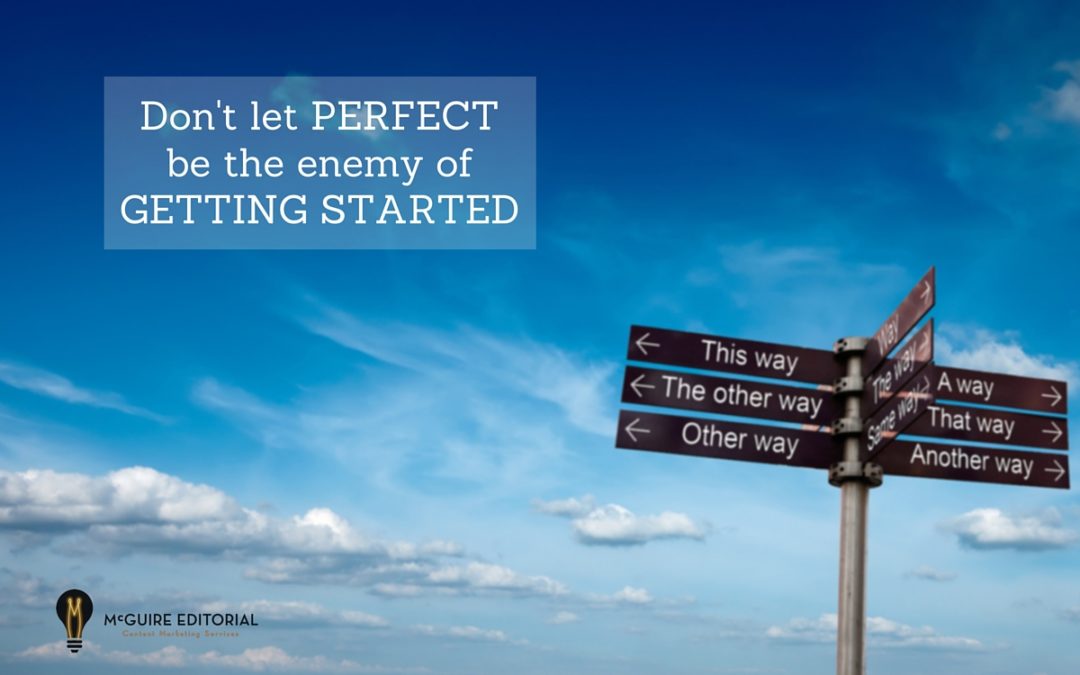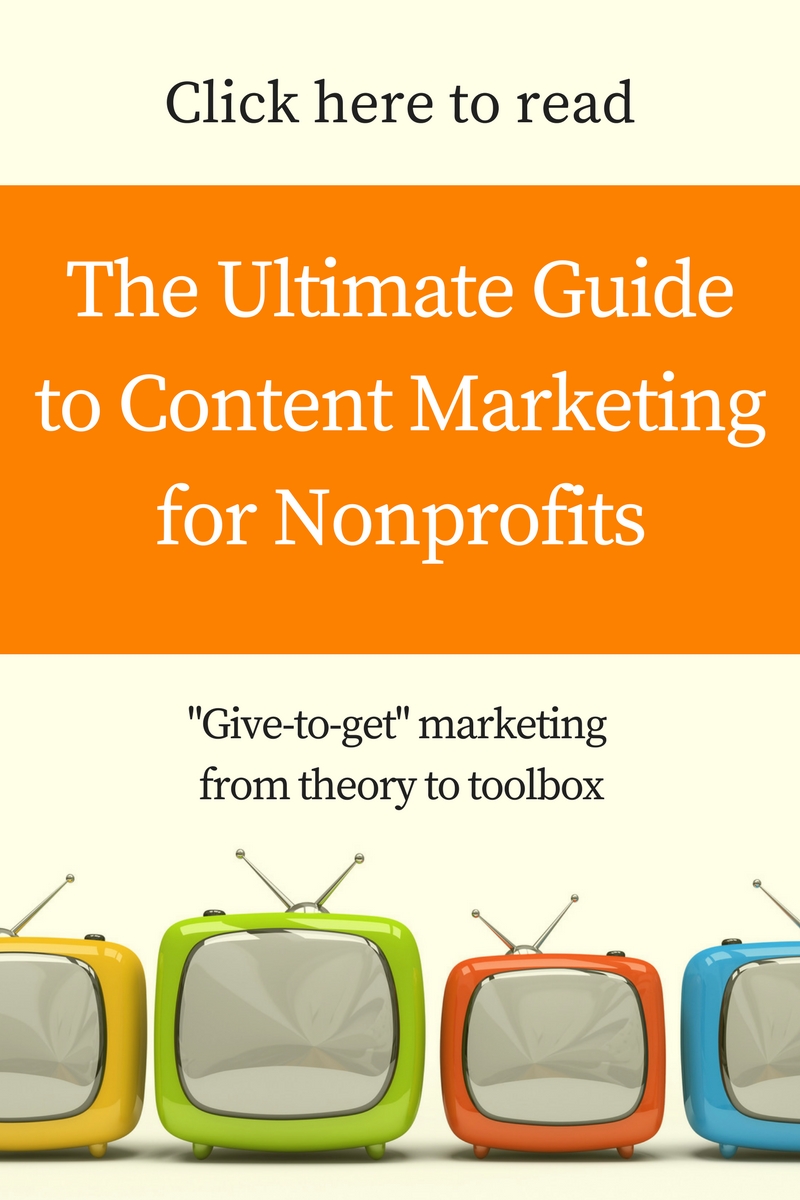“We need to get our content marketing plan going, but we’re not quite ready. First, we need . . . .”
Does this sound familiar? Are you forever postponing the start of your content strategy? Do you feel like you need to wait for some key piece of information or some other development like your next round of funding, a critical hire is on board or some design work? Or are you waiting until your team can huddle to make some major business realignment decisions?
You’re not alone. Startups are born in a state of change and some never grow out of it. Pivoting, innovating, refocusing and repositioning are all constants for growing companies. The irony is many companies utilize agile processes for product development but tend not to be very agile in their content marketing development.
It’s natural to want to have all of your ducks in a row, to have everything — customer personas, branding guidelines, technology tools, website redesign, a clear budget picture — perfectly planned out before diving into marketing strategy.
The perfect content marketing plan is the enemy of the plan you can actually start
That creates a tough dilemma — whether to begin your content marketing strategy as soon as possible or to wait for the stars to align.
Content that is perfectly aligned with a perfect strategy is great, but don’t make perfect the enemy of getting started. There will always be more opportunities incorporate late-breaking developments, but if you wait for those, you’ll never start building your content assets.
Still, you don’t want to be producing content without any thought or preparation. There’s a fine line between agile and reckless.
So we’re offering a content skeleton — a basic, ten-step, six-month content marketing plan — that content managers and marketing directors can use to quickly start making progress while lining up all those ducks for the perfect strategy later.
Assuming you’re already convinced that content is essential to your growth plans, then work through the following items with a bias toward action, and you’ll soon be building material you can test against and improve on later.
1. Focus on mindshare
Decide whose mind you want to be on. Who are you trying to reach within the next six months?
Identify just a couple of customer segments and just a couple of points in the sales funnel to target for now. Are these current customers? Prospects? Influencers in the buying decision or the buyers themselves?
Tools you can use: How a Minimum Viable Buyer Persona Can Help Your Content Plan
2. Think in terms of micro-conversions
Micro-conversions are small actions indicating movement toward a purchase decision. What are the the micro-conversions you want people to make as a result of the content? If you know these, ,then you automatically have a rudimentary measurement plan. Something more comprehensive would be ideal, but these are metrics you can track from the day you make the first blog article live.
Every case may be different, but see if these common micro-conversions make sense for you:
- Top of the funnel: clicking through to additional posts or pages to learn more about you. (e.g. measure how many blog posts lead people to be interested in your About page.)
- Middle of the funnel: signing up for a newsletter to hear more of what you have to say.
- Bottom of the funnel: filling out a contact form so you can start a sales conversation.
How should your content be distributed through the funnel? Until you have a solid plan in place, we recommend a 60/30/10 split — 60 percent of your content on attracting people to the top of the funnel, 30 percent on the middle and 10 percent on the bottom.
Tools you can use: End the Analysis Paralysis: Content Marketing Metrics and Tools You Can Use Today
3. Identify themes: Consider your customer pain points
To start identifying subjects to write about, look at the concerns of your target customers. But don’t fall into the trap of thinking you need to do a comprehensive user survey.
Just ask your product designers, your business development and sales leads, your engineers and your founder what questions, comments and points of sales resistance they are hearing when they talk to the marketplace. The answer to that will seed some of your content.
Tools you can use: Be a Better Marketing Writer By Interviewing Your Experts
4. Identify more themes: What is your expertise? What isn’t?
What does your company know a great deal about? Your team collectively is developing an expertise — an informed point-of-view — about something. If you have some clarity about that, it gives you a great idea about what sort of content you should be developing.
Conversely, what do you wish you knew a lot about? It’s okay not to be an expert on every given topic. What you’re wondering about or struggling with may also be something your target customers would value.
If your customers are interested in a problem for which you don’t have all the solutions, your content marketing plan is an opportunity to find some answers and provide something of value. Remember, great content marketing is, at heart, a plan to discover what you can do for others and to deliver that.
Related reading: Publish Your Expertise: Content Marketing for Professional Services Firms
5. Brainstorm, brainstorm, brainstorm
Now it’s whiteboard and Post-It note time.
Most companies, at this point, will feel that keyword research is necessary to drive content, but this can be another blocker if you let it. Keyword research is important, but it doesn’t have to hold up this part of the process.
Instead, first brainstorm a number of topics you like, and use basic keyword research tools to confirm that there’s some search volume on those topics. Then you can tweak your headlines and your copy to ensure they’re optimized for those search terms.
Even if you have great keyword research, don’t let the tail wag the dog. Come up with great topics first and then see which ones align with your keyword opportunities.
More on this topic: How Good Content Marketing Balances Generic and Specific
6. Organize your editorial calendar
You can find a million editorial calendars out there. Don’t get stuck wading through all the examples and wondering which is best for you. For now, open up a fresh spreadsheet or a Trello board and:
- Decide on the format for each piece — blog post, white paper, ebook, guest post or another site.
- Decide which customer segment each article targets.
- Decide which point in the sales funnel each article targets.
- Stack rank the articles by how confident you are they will be useful or how quickly you want them.
- Decide how much content to plan for.
And how much content should you plan for? For the very basics, we recommend what we call the 26-and-2 plan.
The 26-and-2 plan assumes one blog post per week over six months (26 total) and two other significant content assets. These are anchor pieces, like an ebook or white paper, that make a statement, set a big picture vision or are intended to make a splash in the marketplace.
You can run promotion campaigns around those two big assets, and some share of the blog posts can be on the same themes to help support those campaigns. Also, any blog post you have planned can be converted into a guest post on another website if that opportunity arises.
Tools you can use: Why Every Content Plan Needs a Creative Brief (And This Template!)
7. Gut check your content’s shareability
Nearly as important as getting discovered on search is getting it shared.
One way to assess whether your content ideas are likely to get shared is to ask yourself the simplest of questions: Can I picture the CEO of my company posting this on their LinkedIn page? Has my CEO ever shared anything resembling this?
If not, then think again. If it’s not something the company values, then why would anyone else? An important standard here is making sure you don’t contribute to the plague of clickbait-and-switch marketing.
Another version of this test is to lurk on LinkedIn profiles of your target buyers and look at what they share and comment on. Can you picture your planned content fitting int with that?
Related reading: Your Blog is Not the Same as Content Marketing
8. Set up an editorial process
By “editorial,” we mean the all the steps needed to get it done and looking good, including crafting the assignment, developing sources of information, writing, revising, editing and proofreading. You’ll need to:
- Source your writers.
- Give them clarity about the articles you want.
- Connect them with your internal experts or with partners who can provide insight.
- Identify who is responsible for managing and editing them.
Tools you can use: The 10 Editing Stages a Content Marketing Manager Needs to Plan For
9. Formatting, design and placement
Think about the formatting and illustration stage of the process. For material that will go on your website’s blog, you’ll need to budget time to tweak your content management system and to find header illustrations. For white papers and ebooks, you’ll probably want to involve a designer.
In the case of articles you hope to place in other blogs, which is common for pieces you’ll ghostwrite for the company leadership, remember to budget time to pitch to editors.
Try this: Hiring a Ghostwriter – Because Your CEO Has Big Ideas and Very Little Time
10. Plan for distribution
The basic premise of content marketing is to put something valuable into the channels your customers naturally move through. For most companies, that’s going to be a combination of personal emails, discovery on search, email newsletters, guest posting on influential blogs and sharing on some key social platforms.
It’s important to remember that content marketing is a long game that takes a while to get results. So your distribution efforts are really a series of very small investments in something that will pay dividends later. The tweets and shares probably won’t pile up with that first article, but they’re laying down a foundation that matters more over the long-term.
You may also want to try some marketing technology tools at this stage, in two broad categories — social media marketing tools like Buffer or Hootsuite and lead tracking software like HubSpot or Marketo. These technologies are effective and well-liked, but they’re not necessary for everyone.
One last tool: Want a Successful Inbound Marketing Strategy? Give Better Assignments.
Get going and stay agile
What’s left? Plenty! A perfect content strategy will include a measurement plan, customer personas, some thought about how to align with your brand and value proposition and much more. This six-month, ten-step content marketing plan won’t get you to perfect, but it has the virtue of being doable. Use it to get started swiftly and purposefully without feeling you are working in the dark.

Dan Hajducky
Guest author
Follow Us





